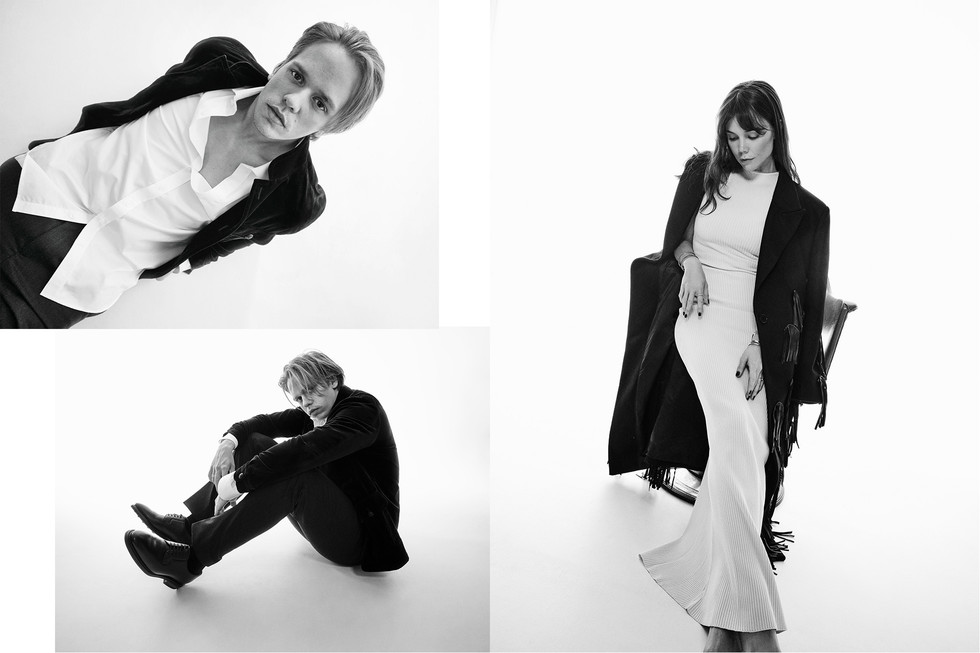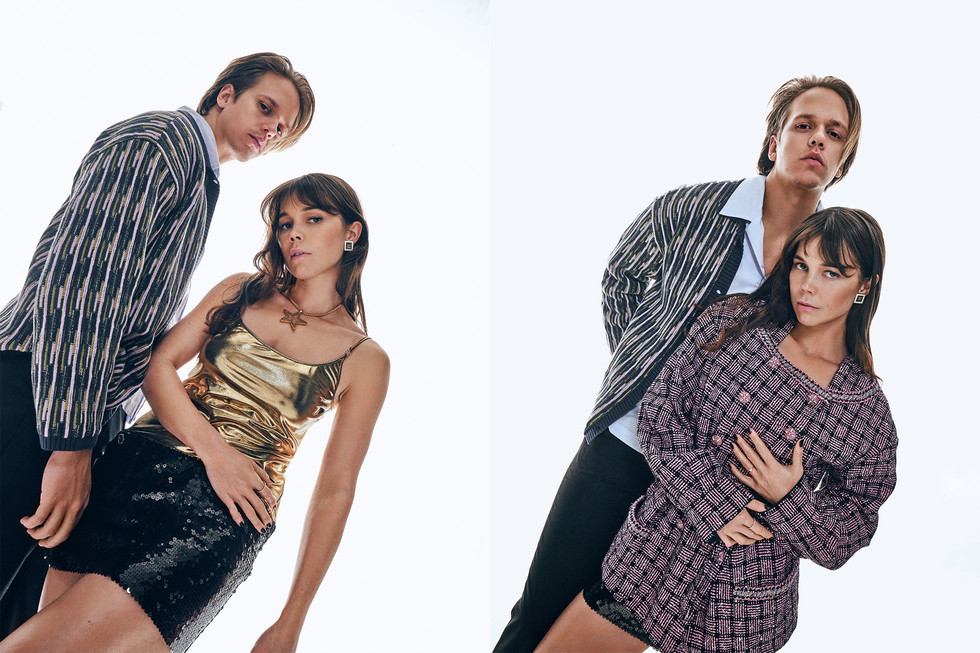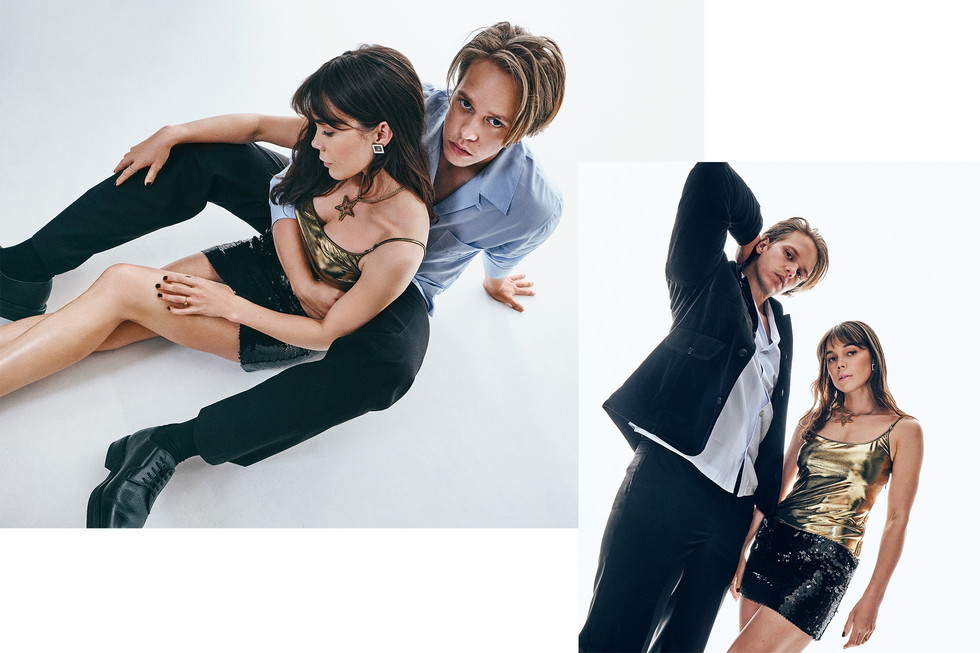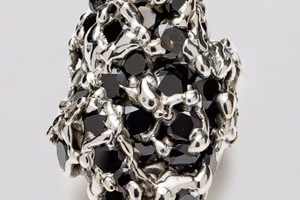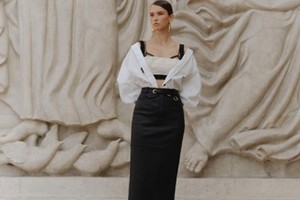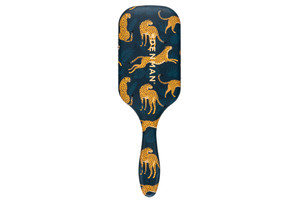Intersections of Art: Astrid Jensen Kruse and Marjolein Rothman
Written by Natalia Muntean“It felt very natural. My paintings speak about photography, and Astrid’s work revolves around photography, but it is very painterly. And we have similar motivations for why we do the work,” says Dutch painter Marjolein Rothman about the shared exhibition with Danish artist Astrid Kruse Jensen. Brought together by Björn Wetterling, the artists have come back to Stockholm with exhibitions currently gracing the walls of Wetterling Gallery. “He suggested that we should share the exhibition, knowing each other's work very well. We had a good feeling about it and it made sense,” explains Kruse Jensen the idea behind the shared exhibition.
“Resonance” by Astrid Kruse Jensen is somewhat of an existential journey catalysed by personal loss, while Marjolein Rothman returns with a series of paintings titled “Orange and Teal”, exploring ideas of fleetingness and the human condition. Even though different at first glance, their artistic trajectories and the current exhibitions hosted by Wetterling Gallery, deeply rooted in personal narratives and explorations of identity, intertwine seamlessly.
Natalia Muntean sat down with the artists as they peeled back the layers of their creative minds, offering glimpses into their profound motivations, divergent mediums, and the intersections that define their artistic journeys.
Natalia Muntean: I would like to know more about the exhibition and how you approached it. Did you treat it as two completely separate exhibitions, or was there a dialogue about it?
Astrid Jensen Kruse: Marjolein and I had participated in group exhibitions together before, and this project space of Wetterling Gallery, which feels more like a two-space gallery, allows for exhibitions to communicate with each other, yet remain separate. It's like Marjolein said - there's so much linked between our work, even though it looks different. The strokes of light, for example. My work is photographic, but because of the chemical traces and the strokes of light, it also has this painterly touch. We both use ourselves as a starting point, drawing from life experiences like grief, loss, and love. It emanates from a deep, personal interest rooted in our hearts, but we want to make it universal, so anyone can relate.
NM: Seems as if you take an essence of yourselves and transmit it through photographs and pictures?
Marjolein Rothman: Yes, and also in our way of working, we take a step back, becoming more analytical while maintaining a strong, personal motivation. I have moments of reflection, considering what works and what doesn't. As a painter, you stand in a long tradition, so what do you do then? I chose classical subjects like architecture, self-portraiture, and flowers. For me, that was daring because painting flowers was the only thing that women were allowed to do. But then I tried to do something that is maybe different and that is also a motivation.
AJK: I am not afraid to work with something beautiful, while always incorporating an element of disturbance. It's never just beautiful; there are always cracks, a duality between beauty and pain, love and loss, darkness and light. This shimmering between these elements is constant. It's quiet and moving at the same time.
MR: And that also depends on how you approach the medium. You, Astrid, choose photographic material that is expired for example. I use just two colours, let the painting appear, and that's it. I don't want to create a fixed image that I build up; I want the work to be in this in-between state, reflecting movement, transformation, and vastness. This is very important to both of us. It's about fleetingness. I care less about traditional norms in painting and more about the direct expression of ideas. Painting isn't solely about technique; it's about conveying what you want to show. Failure is part of the process - erasing, building, scraping - until the light appears, and the image emerges. It's been a journey in painting, but I love it.
NM: When do you know a painting or photograph is ready?
MR: It's linked to a specific moment, much like photography. The connection to the image and the mood during its creation are crucial. I don't precisely know beforehand what I'll paint, but I have a general idea. I work within a short time, around 10 or 20 minutes, and once that's done, the piece is finished. I want the painting to mirror the state of being when I made it. I can't go back and add strokes; the energy needs to be captured in that moment.
NM: You don't alter it after?
MR: No, sometimes I conclude, but altering it feels different energetically. The brushstrokes and everything else reflect the making process, and that's crucial.
NM: It sounds like they live their own lives, and you're just the medium. What about your process, Astrid?
AJK: I think my process is slower. Most often, I write about my images before finding a location. I photograph the same place multiple times. Sometimes, you're there, see the light, and you just know without really seeing or understanding how the chemicals will react; you know this will be it. I prefer getting to know the locations beforehand. That's why I return and photograph again. I place them all on the studio walls and start making selections. It's a slow process, but sometimes, seeing ten pictures laid out, I just know which are the ones. It's different each time, but there's a feeling within, a certain knowing. You can't explain it exactly, but you feel it.
MR: Do you sense it when you take a photo?
AJK: Sometimes when I enter a space, see the light, and I know, inexplicably, I have to be there. Other times, I revisit, seeking a different angle or adjustment. It's about understanding the space I work in.
MR: There's a magical element too, as Astrid mentions the writing and the wonder of it all. I often tell students that while we can teach painting techniques, the wonder doesn't come from that. It's about the spontaneous moments, influenced by everything – the walk to the studio, conversations, films watched. Sometimes, despite efforts, nothing happens, and other times, it just clicks. There's an attempt at control, rituals like using a certain palette, but ultimately, you want things to happen on their terms. Setting the stage for it to happen is key.
NM: Astrid, you mentioned the title Resonance - how do you interpret and adapt this concept in your work?
AJK: It’s the duality of the word 'resonance' that I've been working with and used as a title for the exhibition. It's so beautiful and I was inspired by the German sociologist Hartmut Rosa. He writes that resonance is when you experience things falling into place. It's not about material wealth or physical beauty, but those moments when you might be sitting on a bench, the light hits a certain way, and suddenly, you're filled with a sense of something special and it might arrive when you least expect it. I started this exploration after my husband died in 2019, an event that changed every element of my life. And of course, this experience made me question life's meaning. So, for me, it became an existential journey—to learn to live with the loss, while I also appreciated what I had. And this longing resonated for me, and I was looking for a location where artists before me had experienced some of the same questions. I found this artists’ home built by a woman, a Danish architect. They were still together and hadn't necessarily experienced the loss I did, but they wondered about life's essential elements: a place to live, work, have a family, and find meaning in life. So for me, while looking for these answers, it was important to find a place where people had done that before me. I experienced it not just as the artists´ home but used the house as a location —a stage for something beyond architectural dimensions, something more metaphysical and abstract. Being able to work there while it was empty was like a gift because then I could walk through this home, which was more like walking through a painting because every room has its own colours. The kids who grew up there did not talk about what was in the rooms; instead, they referred to them by colour. These rooms represented hope, dreams, and memories. I felt that this location could kind of provide a lot of what I was looking for.
NM: I have to ask, is that you in the picture?
AJK: No, no. But it's good to ask because my models look like me. It's a common experience, even with painters—to seek models you can somehow relate to. Throughout my work using models, I've always searched for someone I could identify with. It took me a while to realise that they looked like me.
NM: Is that your way of taking a step back?
AJK: For me, yes. I prefer standing on the other side, controlling every little element. So that's also why it mustn't be me. But I think that even though it looks like me, I also hope that it could look like you or that other people could identify with it. But I hope that also by turning their back on you, it's an invitation for the viewer to relate to the photo.
NM: What about you, Marjolein? Is that you in your paintings?
MR: It is, but I can also relate to what Astrid said because I used to speak about myself and other women through pictures of others. I've made a series of portraits of 19th-century Catholic saints, because the Catholic church uses beauty and sexuality to promote their values, and tried to examine how it is to be a woman in this world, what we represent, and what is expected of us. After that, I made a series in the same kind of manner using friends of mine in an attempt to show that we are all the same and we can all represent those values. This is how I used to work and sometimes I would make a self-portrait facing away, to invite viewers to put themselves in the subject's place. In this present exhibition, there is a self-portrait that is difficult because she looks at you, but she also looks into the mirror, at herself. I speak in the third person but it’s me because I photographed myself and then it became a painting. As women, we are used to being mostly the subject of the pictures, and if somebody takes a picture of you, the person who takes the photograph is the person in power. But in the case of my paintings, she takes a picture of herself and she chooses how she depicts herself. If I compare it to the other portraits, it's the first time I’ve made such a daring self-portrait. The self-portraits and the flower series speak about different stages in life, fleetingness, how beauty slips away, and that you cannot hold on to a specific moment, but also about the different roles - what's my role in life? What is my identity?
AJK: I think if you refer to all the male painters, they will have a muse. And then you're your own muse, and I think that's empowerment.
MR: That is also true, but it's difficult because I also don't want to be vain, so I'm examining my position now.
AJK: There is this Finnish photographer, Elina Brotherus, who's using herself all the time, but not in self-portraits. She says, “It's not me, it's a photograph.” And this refers to both of our works. We use ourselves and our bodies. Even though they look like us; it's a photograph or a painting.
MR: Yes, it also speaks about representation. What does a portrait mean? What does it want to say? What does somebody else see? Who sees the portrait?
NM: Marjolein, could you tell me a bit more about the two colours, orange and teal?
MR: Lately I have been painting in blue and red hues. In the flower series, the colour evolved from almost monochrome paintings to black and then more and more colour, eventually focusing on these two. It's also tied to my exploration of Mondrian's work during his move towards abstractions, for example, his depiction of trees. When seen in person, his paintings are almost blinding, they demand attention and are so intense. He painted a red and yellow mill with such intense colours that people thought he was going mad. But he said that he was actually looking into the sun and then at the world and this is what it looked like to him. This concept interested me. So I use these colours to have this kind of effect that you can look at the picture, but almost not, your eyes can hardly focus. And then I found out that these two colours, 'Orange and Teal', are also often used in filmmaking and photography, where you have the cooler hues in the background and the reds to highlight the subject. But I want everything to fuse. So, I called it “Orange and Teal” because of its reference to film and photography. It's about these colours evoking something together and challenging the traditional connotations. Here, the subject isn't just in the foreground or the background. It may seem technical to express that I desire this blurring, but essentially, similar to what Astrid mentioned earlier – I wanted to express something timeless.
NM: But regarding the exhibition, you utilised expired Polaroid films. Can you explain how this choice helped you capture fleeting and ever-changing moments or aspects in your photography?
AJK: I think what I kind of realised by actually moving away from the perfectly shot photograph was that by using a material which also had some unexpected elements and traces of the chemicals that I would never really know exactly how they reacted, I felt somehow that made it even clearer for me. The Polaroid camera, the one that I use, has technical limitations that I find interesting, and after I take the photographs, the Polaroid is more like my negative. So I scan the polaroids afterwards, and then from there, I can enlarge it. And of course, because it's so tiny, then the lack of sharpness becomes even clearer. I think you kind of give yourself some limitations, but these limitations open up a lot. Because within a new frame, you have to push yourself to do things differently.
NM: It seems like you pushed boundaries by amplifying these imperfections, resulting in beautiful interplays with light. And Marjolein, in your painting series, you employ low contrast and parallel lines. Could you explain how they convey the transformation you aim to capture?
MR: Normally, you would see the subjects in the front. In my paintings, even if you can identify a subject, like a flower, by lowering contrast, its visibility diminishes. Your eyes move, trying to grasp what you're seeing. It’s also connected with how we shape our ideas, politically or otherwise. Everything is moving. Everything is uncertain. And we cannot deal with it actually, I think. But I think we should be aware that we are constantly changing and forming our ideas.
NM: So you let viewers work a little for the image.
MR: Yes, I hope so!
NM: You mentioned losing your husband, Astrid, and I'm curious to understand how this process of creating art serves as a means of processing your emotions. Was it a healing journey for you to go into this house and create this image?
AJK: No, I don't see my work as therapy, not to get over something or learn to live with it. I see it more as the loss creating this urge within me to work with the notion of resonance, something I was engaged with. For example, the show I did before, “Floating,” was also about the stage of being present and absent. My art isn't therapy, it won't heal me, but it reflects what's going on within me. It's a process where I feel it shows more about me, not just my story but something universal.
MR: What I find interesting is that sometimes people ask, “What do you want to tell with your work?” But when it comes to my work, I also have questions. There's always a question!
AJK: Yes, it's about how it is to be in the world. How is it to be human?
MR: And I still don't know…
AJK: But I think this honest curiosity leads to finding a way, maybe different than before.
NM: So do you create to find answers to some questions, or do you create because you already found some answers and you want to share them with the world?
AJK: No, I think I always thought that art for me was to create something open-ended that raises questions and curiosity and to look at what you maybe think you know, and then question it. For me, it's about opening new ways of being in the world, rather than just answering questions.
MR: That's interesting to me as well. And sometimes people can engage with it, but I'm not aiming at that. It’s about exploring questions that I have. I would say it's a way to live, a kind of ritual. I paint and some might find it useless—why spend a lifetime painting? Why would you do that? But it's a way of living through the process. It's about asking questions and it's wonderful when someone else can relate. I don't have a strategy for it, but it's very special when others can also relate to my questions and my work.
NM: Marjolein, your motives for flowers and self-portraits are described as nods to Vanitas and Memento Mori. How do these references contribute to your exploration of the fleeting nature of life?
MR: It's always been my theme. I find it very difficult to deal with the concept of things ending. So I have painted flowers from time to time, but never really took on the challenge of painting a whole series of them. And considering the tradition, that is something that you do, you start with. And so I did, I painted flowers for seven years. Looking back, it started when my mom died, so it was quite logical as a theme because of its memento mori connotations. I also found out that it is not only about death, decay, and fleeting beauty but also about something new, it is about transformation.
NM: And how do you hope the viewers will perceive the connection between your works that are different, but very connected still?
MR: I hope there's a specific atmosphere here that creates a connection. We talk about concepts and motives, but ultimately, because both our works are rooted in and discuss the human condition, I want people to look at the work and feel something.
NM: Are there specific emotions you'd like to connect with it?
AJK: I think when it comes to exhibitions, and when it comes to art in general, sometimes you don't get touched at the moment, but then you wake up two days later and realise there was something there and you have to go back and find out. So I hope people will be curious and see the similarities in our approaches, our curiosity on how we work with each medium and the connectedness even though the mediums are different. And I think if people get touched, I'm happy.
Installation photos: Jean Baptiste Béranger






